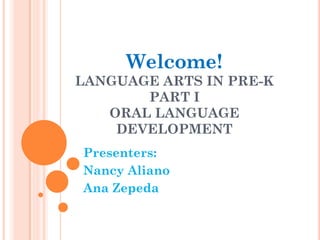
Oral language presentation fall 12
- 1. Welcome! LANGUAGE ARTS IN PRE-K PART I ORAL LANGUAGE DEVELOPMENT Presenters: Nancy Aliano Ana Zepeda
- 2. FUNCTIONS Oral language is the foundation of literacy. Building a child's oral language skills will ultimately improve his reading skills as well. 8
- 3. SIGNIFICANCE OF ORAL LANGUAGE Languageskills are important in order to make connections with others and understand experiences. Majorityof vocabulary derives from experiences. Teach the essentials of oral language to build upon it for a higher mental development. 6
- 4. LANGUAGE: A MENTAL TOOL When children use symbols (letters) and concepts (rhyming) to think, they no longer need to have an object in order to think about it. Language allows children to imagine, manipulate, create new ideas and share those ideas with others.
- 5. THE MIND Society contributes to the way a child’s mind work. According to Vygotsky; children could not learn logical thinking without having mastered language.
- 6. RECEPTIVE & EXPRESSIVE LANGUAGE They are different but equally important! Phonological awareness includes attending to speech, discriminating between sounds, holding sounds in 5 memory.
- 7. LISTENING EXERCISE ♦ II.D.6 CHILD INCREASES LISTENING VOCABULARY AND BEGINS TO DEVELOP VOCABULARY OF OBJECT NAMES AND COMMON PHRASES IN ENGLISH (ELL).
- 8. LISTENING Listening is a two-way street. Strategies “Story Time” with no pictures. Ask what they understood at the end. Singing songs with no music gives students the chance to hear and produce the words of the song. Taking it home: Ask students to sing the song to their parents and have parents write what the child sings. II.B.3 Child provides appropriate information for various situations.
- 9. PURPOSEFUL TALK Parallel Talk: an adult describes what the child is doing Self-Talk: an adult talks about what he or she is doing, using short sentences. Example: At snack time, an adult says, “I am crushing up crackers and putting them in my chicken noodle soup.” Expansion: An adult adds more information to the sentences that the child expresses. Example: A child says, “A fire truck!” An adult responds, “There is a big, yellow, fire truck with a siren!” Hart Paulson, Lucy, Ed.D.,CCP-SLP & Louisa C. Moats, Ed.D. LETRS for Early Childhood Education. 2010
- 10. YOU TRY IT! Work with the people at your table to expand these utterances. 1. “Ball.” 1. “A dog a bone.” 1. “Her falled down.” 1. “He made a big bubble.”
- 11. WHAT IS A WORD? Recognizing what a word is What does it look like? What does it sound like? What are the characteristics of a word? After students know what a word is then you can expand to teach them what a sentence is. ♦ II.E.1 Child typically uses complete sentences of four or more words and grammatical complexity usually with subject, verb, and object order.
- 12. ALLITERATION Comparing Sounds Guess What I am thinking/Adivina lo que estoy pensando (Mystery Bag) Animal Sounds (Think of a word that starts with the sound as your name)
- 13. RHYMING Rhyming with our bodies Rhyming Train Rhyme “Hola, Hola, Coca Cola.” Rhyming Names/Nombres que Riman Start with made up words We want them to understand the concept not memorize the cards
- 14. Let’s have a mental break
- 15. ANYTIME IS A GOOD OPPORTUNITY TO PROMOTE ORAL LANGUAGE ♦ II.D.1 CHILD USES A WIDE VARIETY OF WORDS TO LABEL AND DESCRIBE PEOPLE, PLACES, THINGS, AND ACTIONS. ♦ II.E.7 CHILD ATTEMPTS TO USE NEW VOCABULARY AND GRAMMAR IN SPEECH (ELL).
- 16. STUDENTS ENGAGING IN MEANINGFUL CONVERSATIONS II.B.1Child is able to use language for different purposes.
- 17. CHILDREN ACTING IS AN ORAL LANGUAGE OPPORTUNITY
- 18. CENTERS A BIG PLACE FOR ORAL LANGUAGE OPPORTUNITY
- 19. ORAL LANGUAGE PRACTICE HELPS STUDENTS TO BECOME LEADERS
- 20. MODELING HOW TO PLAY IN CENTERS
- 21. MUSICAL CHAIR ACTIVITY II.A.2 CHILD SHOWS UNDERSTANDING BY FOLLOWING TWO-STEP ORAL DIRECTIONS AND USUALLY FOLLOWS THREE-STEP DIRECTIONS.
- 22. I.B.2B CHILD IS AWARE OF FEELINGS MOST OF THE TIME. I.C.4 CHILD INCREASINGLY INTERACTS AND COMMUNICATES WITH PEERS TO INITIATE PRETEND PLAY SCENARIOS THAT SHARE A COMMON PLAN AND GOAL. VII.B.1 CHILD DEMONSTRATES THAT ALL PEOPLE NEED FOOD, CLOTHING, AND SHELTER. VII.B.3 CHILD DISCUSSES THE ROLES AND RESPONSIBILITIES OF COMMUNITY WORKERS.
- 23. GOALS Think about your students. What are your goals this year regarding Oral language development?. Make sure you differentiate the different levels they bring to school. Turn to a person and share
- 24. WHEN CAN I PROMOTE ORAL LANGUAGE? Asking and answering questions Pair conversations Transitions Center time/activities Singing songs and rhymes Giving students opportunities to speak at anytime 32
- 25. TEACHING THE RULES OF LISTENING AND SPEAKING IN YOUR CLASSROOM.
- 26. SO HOW DO YOU FEEL NOW? Do you feel you will have more things to do now? Or you think that now you have a better idea of how to plan for a purposeful time to engage students in meaningful conversations that will enrich their experience in your classroom?
- 27. ORAL LANGUAGE DOESN’T HAVE TO COST MUCH BUT YES, IT NEEDS TO BE PLANNED
- 28. ORGANIZE YOUR IDEAS = MENTAL TOOL
- 29. What strategies will you be using in your classroom to fill in the gap? Turn and discuss with your neighbor
- 30. MAKE AND TAKE Songs Alliteration chart Conversation starters for centers Syllable clapping Rhyming sheet and pictures Questions what where when what... KWL anchor chart Feeling faces vocabulary Phonics for English and Spanish Problem and solution
- 31. Choose a song that you would like to start working with your kids. Get creative and put it on chart paper.
- 32. THANK YOU FOR COMING! We enjoyed having you today Next session will be January 24 “Read Aloud and story time, the advantages” Can my students read? Thank you! Ms. Aliano and Ms. Zepeda